Preparing Your Industrial Warehouse for Seasonal Changes: A Comprehensive Guide
Understanding the Importance of Seasonal Preparation
As the seasons change, so do the demands on your industrial warehouse. Each season presents unique challenges that can impact your operations significantly. Preparing your warehouse appropriately can help maintain efficiency, safety, and productivity. Whether you are dealing with winter's chill or summer's heat, proactive measures can prevent costly disruptions.
The key to effective seasonal preparation is recognizing the specific challenges each season brings. For example, cold weather can affect machinery, while hot temperatures might impact stored goods. By understanding these dynamics, you can plan ahead to ensure your warehouse remains operationally sound throughout the year.

Winterizing Your Warehouse
Winter introduces several challenges, from freezing temperatures to increased humidity. To combat these, ensure that all heating systems are functional and efficient. Proper insulation is crucial to maintaining a stable internal temperature and protecting your inventory from extreme cold.
Additionally, consider conducting a thorough inspection of your roofing and gutter systems. This step is essential to prevent leaks caused by heavy snow or ice buildup. Regularly clearing snow from walkways and loading docks is also critical to maintaining safety and preventing accidents.
Preparing for Spring and Summer
As temperatures rise in spring and summer, warehouses must address issues such as overheating and increased humidity. Ensure that ventilation systems are in good working order to maintain air quality and temperature control. It might be necessary to install additional fans or dehumidifiers if your warehouse lacks adequate ventilation.

Perform regular maintenance checks on cooling systems to prevent unexpected breakdowns. Consider installing sunshades or reflective roof coatings to minimize heat gain. These steps help protect both your inventory and employees from the effects of excessive heat.
Managing Seasonal Inventory Fluctuations
Seasonal changes often bring fluctuations in inventory levels and types. It is important to adapt your storage strategies accordingly. Implementing a dynamic inventory management system can help optimize space utilization and ensure that high-demand items are easily accessible.
Consider utilizing vertical space and reconfiguring storage layouts as needed. This approach allows for greater flexibility and efficiency in handling seasonal inventory changes, ensuring that your warehouse operations remain smooth and cost-effective.
Enhancing Safety Protocols
Safety should always be a top priority, especially during seasonal transitions when conditions can change rapidly. Regular training sessions for employees on seasonal hazards can minimize risks. Emphasize the importance of using appropriate personal protective equipment (PPE), such as gloves and boots, during winter months.

In warmer months, ensure that staff stays hydrated and takes regular breaks to avoid heat-related illnesses. Implement clear signage throughout the warehouse to indicate potential hazards associated with seasonal changes.
Leveraging Technology for Seasonal Adaptation
Technology can play a pivotal role in preparing your warehouse for seasonal changes. Advanced climate control systems can automatically adjust temperatures and humidity levels based on real-time data, ensuring optimal conditions year-round. Additionally, predictive analytics tools can help forecast inventory needs based on past seasonal trends.
Investing in smart technology not only enhances operational efficiency but also reduces energy costs and minimizes the risk of damage to goods. Stay informed about the latest technological advancements to keep your warehouse at the forefront of industry standards.
Conclusion: Planning Ahead for Success
Preparing your industrial warehouse for seasonal changes is an ongoing process that requires attention to detail and proactive planning. By understanding the unique challenges of each season and implementing effective strategies, you can safeguard your operations against disruptions and maintain a high level of productivity.
Remember, the key to success lies in regular maintenance, employee training, and leveraging technology to adapt seamlessly to changing conditions. With the right approach, your warehouse can thrive in any season.
